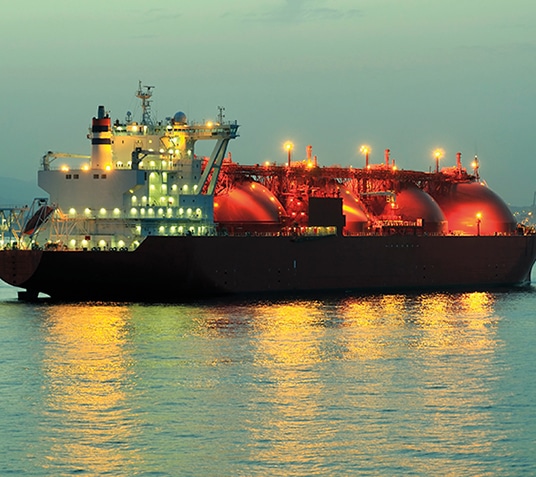DIPLOMA IN
LNG Shipping
Who is This Course Suitable For?
The course is a very useful learning tool for all those who wish to enter the LNG Shipping Transportation Industry. It will also serve to fill in the gaps of knowledge and give a better grounding to those professionals already in the Industry (Captains, Engineers, Navigators, Superintendents, Shipping Company Technical Staff, Ship Inspectors, Flag Administrations, Ship Yards, Repair Yards, Suppliers, Educators, Trainers and Manufacturers).
Duration:
12 – 18 months
Modules:
13 in total
Cost:
Diploma: £2,950
Certificate: £2,150
Recognised by: 
About the Course
This course is unique to the LNG Shipping Transportation Industry. It covers all the theoretical and practical aspects of the IMO LNG Training requirements and much more. There is a 25% growth of LNG Carriers as the demand for LNG as a clean fuel continues to grow. There is a desperate worldwide shortage of trained technical personnel to man ships and their support network ashore. The course will help debunk the safety fears that some have, and will assist those who wish to enter a very lucrative and rewarding career in the LNG Industry.
Studying this Diploma is a great way to boost your career prospects. Many students study to develop themselves in their existing role, while others study with a complete change of career in mind.

Course Structure
The course consists of 13 modules. All students are required to successfully complete and pass the module assignments. Diploma students will also be required to sit and pass a final examination.
1. Introduction To Liquefied Natural Gas Carriers
- What is LNG
- Properties of Methane & LNG
- World Energy Demand
- History of LNG Shipping
- LNG Ships
- Materials and Strength of Ships
- Gas Carrier Rules & Regulations
- Liquefied Gas Carriers
- LNG as a Marine fuel
2. International Code For The Construction & Equipment Of Ships Carrying Liquefied Gases In Bulk (IGC CODE)
- Brief Description of International Maritime Organisation (IMO)
- The LGC Code
- Gad, LNG Properties and Definitions
- Ship Survival Capability
- Ship Arrangements for LNG Ships
3. LNG Carrier Design And Construction
- LNG Carrier Design Factors
- LNG Carrier Market Supply
- Hull Form Selection
- LNG Containment Selection
- Boil Off Gas Handling
- LNG Carrier Propulsion Selection
- LNG Containment Systems
4. LNG Containment Systems
- LNG Containment Systems
- GTT Mark III LNG Tank Systems
- GTT NO96 LNG Tank System
- Moss Spherical Tank
- IHI SPB Tanks
- Other LNG Containment Designs
5. Carrier Propulsion Systems
- Factors for Choosing Propulsion Plant for LNG Carriers
- Steam Turbine Propulsion Plant
- Ultra High Pressure and Temperature Turbines Dual Fuel Diesel Electric
- MEGI (2 Stroke) and 4 Stroke DF Man Engines
- Coges Plant (Combined Gas Turbine Electric & Steam)
- Other alternative Propulsion Systems
6. LNG Cargo Operations
- Ship Shore Compatibility
- Mooring and Fendering Installations
- Cargo Operation Procedures
- Ship Shore Emergency Shut Down Systems
7. Custody Transfer
- What is Custody Transfer?
- Measurement Operations
- Automation, Safety and Control Systems
- High Voltage Electric Plant on LNG Ships
8. LNG Accidents
- Physical Hazards of LNG
- Human Factor Issues in the Marine Industry
- LNG Accidents
- Guidance on Risk Analysis & Safety on LNG Spills
- Mitigation of Risk LNG Ship Management
9. LNG Ship Management
- Ship Management System Requirements
- Training and Certification of Seafarers
- International Safety Management Code (ISM)
- The Maritime Labour Convention 2006
- Duties of a Ship Superintendent
10. Flag and Port State Control
- Port State Control
- Regions and Co-Operation Between Port States
- Port State Control Inspections
- Deficiencies and Detentions
- Commercial Implications of Port State Detentions
- Maritime Labour Convention
11. LNG Ship Inspections
- Annual Surveys
- Surveys During Construction of LNG Ships
- Surveys After Construction of LNG Ships
- SIRE Inspections
- Buyers Inspections
12. Firefighting on LNG Ships
- General Discussion of Fire Safety
- Sources of Ignition
- Fire Suppression
- Fire Control Plans
13. Classification Societies And LNG Carriers
- Definition of Classification Society
- History of Classification Societies
- International Association of Classification Societies
- American Bureau of Shipping (ABS)
- Lloyds Register (LR)
- Indian Register of Shipping (IRS)
- Periodical Surveys of Cargo Installations on LNG Ships
- Current Status of LNG Carriers
Career Pathway
Career Path
Those ashore can develop into areas of LNG operations
Salary
Depending on position, you could earn £100k and above
Duties
Duties include a range of different roles within the management of LNG ship operations
Meet the Course Director
Ian Biles
Managing Director at Maritime Services International
Ian has led MSI to become one of the world’s leading surveying companies. Ian’s qualifications include: Master Mariner, RYA Yachtmaster Ocean, Naval Architect (BEng Ship Science) and Business Management (MA Business Management).


DIPLOMA IN LNG SHIPPING
On passing the Diploma, you will receive the above icon. Please use it on your business cards, LinkedIn profile and website(s)!
You can also use these letters after your name: MTA Dip LNG Ship
Flexible
Supportive
While the nature of distance learning is independent study, we recognise the importance of support. Students can contact us at any time during their course for assistance and our team of industry experts are always on hand for advice.
Expertise
We have over 50 industry experts writing, developing and advising on our course material. We truly believe that allowing students to tap into their expertise and knowledge is of the utmost importance to fulfil your dream career.
If you would prefer to complete this as a classroom-based course, please contact us.
FAQs
How long do the courses take to complete? What's the difference between a Diploma and a Certificate? Read through our Frequently Asked Questions below to find out the answer.

















 Sign-up to receive email updates
Sign-up to receive email updates